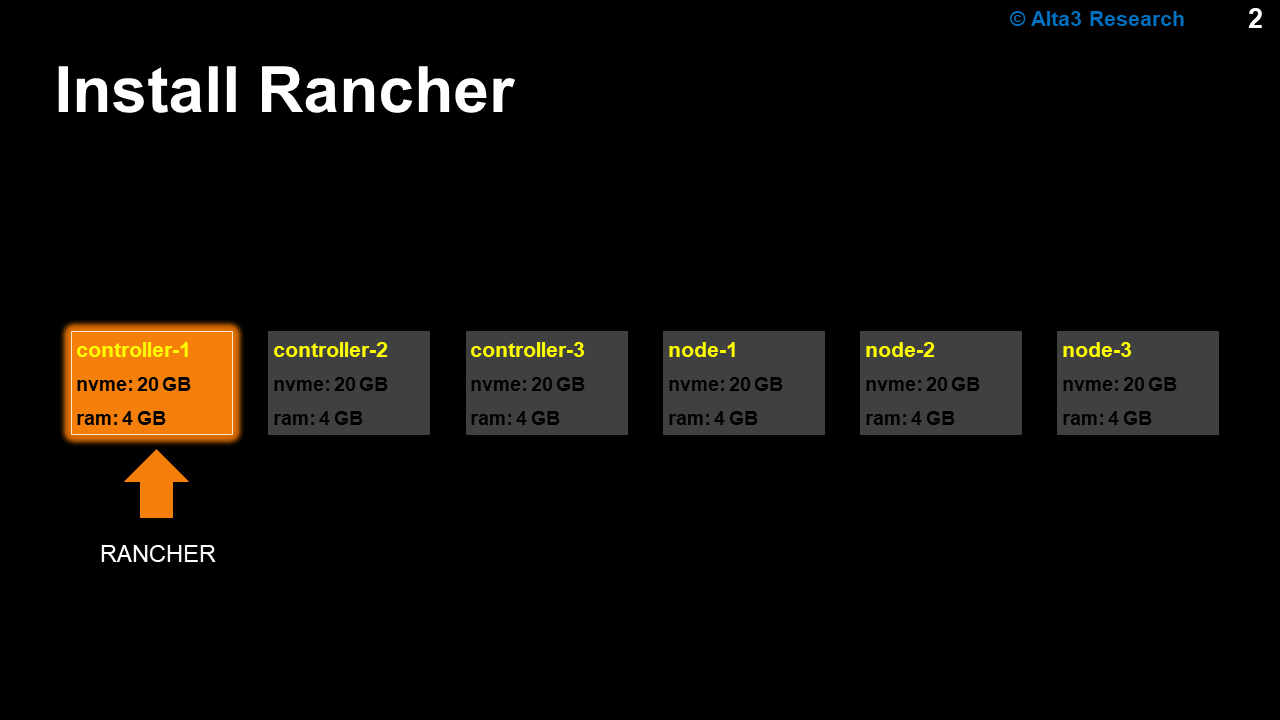Installing Rancher with ansible - Lesson 1
Author: Stu FeeserGetting started
The first step in planning an ansible playbook is to record the steps to be automated. Almost always, that means you need to write a bach script, or at least the bash steps.
Start the Lab Environment
Objective
Here is the demo environment we will be using to start this Rancher Kubernetes journey! Our goal is to automate these steps using ansible. Doing so lays down the obvious requirement that we understand the manual installation first. Let’s get started with that.

If you want to try this yourself, all you will need is two machines:
1. A “bchd” machine where you will run ansible
2. A “target” machine where you will be installing Rancher
In this demonstration, your instructor will:
✅ Run the lastest Rancher container.
✅ Obtain the Bootstrap Password.
✅ Explain the bash commands.
✅ Write an ansible playbook to automate the above bash steps.
Demonstration
-
Install rancher on a node called controller-1.
sshto that node.student@bchd:~$ssh controller-1Type
yeswhen prompted. -
We need docker which will then run the rancher container, so install docker as follows.
student@controller-1:~$sudo apt install -y docker.io -
Start the rancher container.
student@controller-1:~$sudo docker run -d --restart=unless-stopped --name rancher -p 80:80 -p 443:443 --privileged rancher/rancher:v2.8.4Note that your rancher container will listen on TCP port 80 and 443. Also note that the container is running in privileged mode. This means the container is given full control over the host. As always, WITH GREAT POWER COMES GREAT RESPONSIBILITY.
-
Run the following command to view the logs of your rancher installation. Feel free to watch these logs for 10 seconds or so. They are showing you all of the steps that Rancher is taking to get itself set up. To exit type Ctrl-c.
student@controller-1:~$sudo docker logs -f rancherWhen you feel you have watched enough logs to get the feel, exit from watching the logs. To exit, press
Ctrl-c. -
You will need a password to connect to the rancher web interface and that password you need is IN THE LOGS. Grep for the password using the following command to save it into the file called pswd.txt.
student@controller-1:~$sudo docker logs rancher 2>&1 | grep "Bootstrap Password" | awk '{print $6}' | sudo tee pswd.txt
The bash script:
Here is the bash script that performs the above tasks:
-- CLICK for the bash Script --
ssh controller-1 sudo apt install -y docker.io
ssh controller-1 sudo docker run -d --restart=unless-stopped --name rancher -p 80:80 -p 443:443 --privileged rancher/rancher:v2.6.9
echo
echo sleeping 120 seconds from
date
sleep 120
ssh controller-1 sudo docker logs rancher 2>&1 | grep "Bootstrap Password" | awk '{print $6}' | sudo tee pswd.txtAnsible automation:
Here is an asible playbook that automates those bash steps from above. The full explaination of the playbook below is in Chad’s video:
-- CLICK for Playbook EXAMPLE --
#!/bin/bash
# Create the inventory file
cat << EOF > inventory.ini
[rancher]
controller-1 ansible_user=student ansible_become=true
EOF
# Create the playbook file
cat << EOF > install_rancher.yml
- name: Install Rancher on controller-1
hosts: controller-1
become: true
tasks:
- name: Install Docker
apt:
name: docker.io
state: present
update_cache: yes
- name: Start and enable Docker service
systemd:
name: docker
state: started
enabled: yes
- name: Run Rancher container
command:
cmd: >
docker run -d --restart=unless-stopped --name rancher
-p 80:80 -p 443:443 --privileged rancher/rancher:v2.6.9
args:
creates: /var/lib/docker/containers/rancher
register: rancher_run
changed_when: rancher_run.rc == 0
- name: Wait for Rancher to initialize
pause:
seconds: 120
- name: Get Rancher Bootstrap Password
shell: |
docker logs rancher 2>&1 | grep "Bootstrap Password" | awk '{print \$6}'
register: rancher_password
changed_when: false
- name: Save Bootstrap Password
copy:
content: "{{ rancher_password.stdout }}"
dest: /home/student/pswd.txt
owner: student
group: student
mode: '0600'
EOF
# Run the playbook
ansible-playbook -i inventory.ini install_rancher.yml